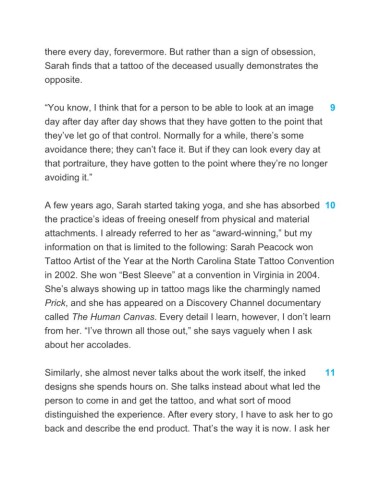Page 1109 - Wordsmith A Guide to College Writing
P. 1109
there every day, forevermore. But rather than a sign of obsession,
Sarah finds that a tattoo of the deceased usually demonstrates the
opposite.
“You know, I think that for a person to be able to look at an image 9
day after day after day shows that they have gotten to the point that
they’ve let go of that control. Normally for a while, there’s some
avoidance there; they can’t face it. But if they can look every day at
that portraiture, they have gotten to the point where they’re no longer
avoiding it.”
A few years ago, Sarah started taking yoga, and she has absorbed 10
the practice’s ideas of freeing oneself from physical and material
attachments. I already referred to her as “award-winning,” but my
information on that is limited to the following: Sarah Peacock won
Tattoo Artist of the Year at the North Carolina State Tattoo Convention
in 2002. She won “Best Sleeve” at a convention in Virginia in 2004.
She’s always showing up in tattoo mags like the charmingly named
Prick, and she has appeared on a Discovery Channel documentary
called The Human Canvas. Every detail I learn, however, I don’t learn
from her. “I’ve thrown all those out,” she says vaguely when I ask
about her accolades.
Similarly, she almost never talks about the work itself, the inked 11
designs she spends hours on. She talks instead about what led the
person to come in and get the tattoo, and what sort of mood
distinguished the experience. After every story, I have to ask her to go
back and describe the end product. That’s the way it is now. I ask her

